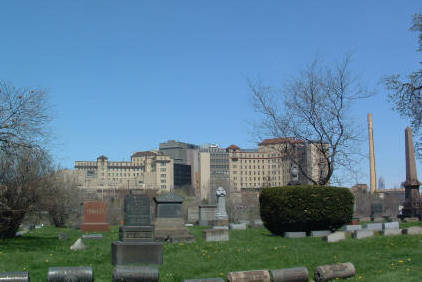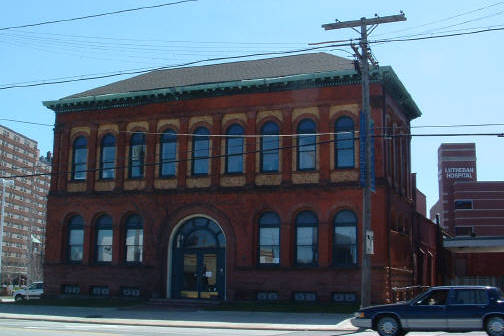
Institutions

Cuyahoga County OHGenWeb |

| Institutions |
 |
| Institutions can be wonderful sources of genealogical information. Also they can prove to be the answer to relatives who "dropped off the face of the earth." Watching details in records like the census can provide clues to someone's whereabouts. Institutions range from hospitals and asylums to homes for unwed mothers, orphanages, prisons and schools for different disabilities. Finding records for them can be a challenge. Some remain with the institution, some are in record repositories. Ohio Historical Society has many of these records. Photos by Laura Hine. Left MetroHealth Medical Center from Riverside Cemetery. Right old Cinecraft building at 2515 Franklin, surrounded by Lutheran Hospital. |
TIMELINE OF HOSPITALS OR MEDICAL CARE FACILITIES IN CUYAHOGA COUNTY:
Old Age Homes
Orphanages
By Laura Hine. Information from: "History of the Charities of Cleveland 1796-1896", by the Cleveland Centennial Commission. CORRECTIONAL INSTITUTIONS
CHARITIES IN CLEVELANDThe first permanent benevolent institution of any note is the Protestant Orphan Asylum organized in 1852, at a meeting held for the purpose in the Old Stone Church. A little household was arranged in a house at the corner of Ohio and Erie Streets. The domicile was established with a family of 11 children under 8 years of age. Miss Sophia Hewitt was the superintendent and teacher for the first two years. In 1853 an acre of land at the corner of Kinsman and Willson was donated for the site and in 1855 the asylum moved to its new quarters. An additional acre was purchased later by the asylum. In 1877 Mr. Leonard Case donated a valuable tract of land 4 1/4 acres on St. Clair Street as a site for the new building, but the officers were unable to use it until the generous donation of Mr. J.H. Wade of $40,000. In the Spring of that same year Rev. Rappe, Bishop of Cleveland, established a small hospital for the care of the sick and injured in the city. This was on Monroe Street on the west side. More space was required and in 1865 a spacious building on Perry Street between Garden and Marion was opened to the public. The Autumn of 1852 saw the beginning of St. Vincent's Orphan Asylum, also began by Bishop Rappe. The Sisters of Charity took care of orphan boys. A two story frame house was erected. Four years later a larger brick building was built on the same site although it was not completed for some years. Since that time St. Joseph's Orphan Asylum on Woodland Avenue was established and St. Mary's Female Orphan Asylum at 103 Herman Street. The Jewish Orphan Asylum was opened in September of 1868 in a building on Woodland Avenue. The Young Men's Christian Association was organized in 1866 and became one of the leading organizations of the City. In 1872 the Association purchased the building at 79 Public Square where the headquarters remained until 1881. In 1881 the headquarters were moved to 64 Euclid Avenue. The Home for the Aged Poor was found by Bishop Rappe in 1870. It is conducted by the members of the Little Sisters of the Poor. The House of Maternity was located on Marion Street and was conducted by the Sisters of St. Augustine. The Society of the Cleveland Bethel Union was incorporated in 1867 and its mission was to establish a home for seamen, railroad men, and other transient sojourners. In 1868 the building at the corner of Superior and Spring Street was purchased. The Society for Organizing Charity was instituted in 1882 with the objective of investigating, relieving and reducing the pauperism of the City. The most comprehensive of the benevolent enterprises of this city is the Women's Christian Association. It was organized in 1868. The first work consisted of Sabbath visitations at hospitals, the work house and the infirmary and making garments to be sold to the poor and instructing women in the art of household economy. A small boarding home for young working women was maintained until November, 1869 when the late Stillman Witt gave the building and land at 16 Walnut Street for that purpose. The association founded the Retreat for the reclamation of fallen women and conducted it until Leonard Case donated a large lot on St. Clair St. and Mr. Joseph Perkins gave $10,000 to start a building fund. In 1883 Mr. Perkins added a hospital and nursery department, thus completing the structure of today. The Home for Aged Women on Kennard Street was erected and given to the Association in 1876 by Amasa Stone. The educational and industrial union is a new branch of the Association designed to supplement the defective education of young working women by giving specific instruction in industrial arts. The Young Ladies Branch of the Association has turned its attention to the necessities and suffering of the neglected children of the poor. Two pleasant day nurseries are conducted, one at the corner of St. Clair and Sterling and the other at the corner of Case Avenue and Orange Street. Another much needed branch of this work is the Home for Incurable Invalid Women and Children on Detroit Street. Both the land and buildings were a gift of Mrs. Eliza Jennings. The Industrial School and Farm on Detroit Street began in 1854 when a few Christian people were moved by the destitution of the children in the vicinity of Canal and Water Streets. They organized a Sunday school for their benefit. Food and clothing were distributed to the attendants of the school which was known as the Ragged School. Supplies were exhausted and in two years the school was discontinued. The Industrial School and Farm was opened in 1857. The Children's Aid Society was organized in 1857 and received the general management of the school. A Branch school was established at the corner of Branch and York Streets. These were public schools. In 1865 the Children’s Aid Society was incorporated and two years later it rented the Jennings Farm on Detroit Street to give the children instruction in farming. Mrs. Eliza Jennings became interested in the school and in 1868 donated the entire property for its use. This gift included 10 1/2 acres of land and a two-story brick dwelling. In the following September, Leonard Case donated 26 acres adjoining and this with 26 acres purchased by interested friends made more than 60 acres. In 1881 the present building was erected and presented to the Society by Mr. Amasa Stone. The Women's Christian Temperance Union was organized on March 13, 1874. The Central Cleveland Women's Temperance Union was originally connected with the non-partisan union but in the summer of 1885 separate organizations were formed. The Dorcas Society was organized about 1866 for the purpose of a relief society. Its main objective was the assistance of widows and children, furnishing clothing, paying rent, and caring for the sick who fall outside the City work. The Trinity Church Home for the Sick and Friendless is situated at the corner of Euclid and Perry Street. The Aged and Infirm Israelites Home is on Woodland Avenue at the corner of Willson Avenue. The Convent of the Good Shepherd was founded on July 8, 1829. The Cleveland Convent was founded by Bishop Rappe in July 1869 and in 1875 the large convent building on Sterling Avenue was completed and occupied. It is intended as a reformatory for women and a protectory for children. The Cleveland Humane Society was organized in 1873 as the Cleveland Society for the Prevention of Cruelty to Animals. The Infants Rest at 1416 Cedar Avenue is an outgrowth of the needs of the Society which fills a need not covered either by city or private charities. Source: LINKS
|
|
© Cuyahoga County OHGenWeb 2013-122 All Rights Reserved. |